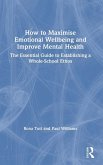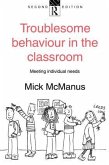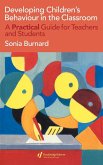Sarah Butler
Polyvagal Theory in the Classroom
A Guide to Empower Educators and Support Dysregulated Children and Young People
Sarah Butler
Polyvagal Theory in the Classroom
A Guide to Empower Educators and Support Dysregulated Children and Young People
- Gebundenes Buch
- Merkliste
- Auf die Merkliste
- Bewerten Bewerten
- Teilen
- Produkt teilen
- Produkterinnerung
- Produkterinnerung
Polyvagal theory provides a breakdown of how the nervous system responds and reacts to unconscious messages of safety and threat. This accessible guide explores polyvagal theory and its potential for fully understanding and supporting the behaviours of children and young people in emotional distress at school.
Andere Kunden interessierten sich auch für
![Teaching without Disruption in the Secondary School Teaching without Disruption in the Secondary School]() Roland ChaplainTeaching without Disruption in the Secondary School217,99 €
Roland ChaplainTeaching without Disruption in the Secondary School217,99 €![Empowering EAL Learners in Secondary Schools Empowering EAL Learners in Secondary Schools]() Joanna KolotaEmpowering EAL Learners in Secondary Schools194,99 €
Joanna KolotaEmpowering EAL Learners in Secondary Schools194,99 €![How to Maximise Emotional Wellbeing and Improve Mental Health How to Maximise Emotional Wellbeing and Improve Mental Health]() Rona TuttHow to Maximise Emotional Wellbeing and Improve Mental Health195,99 €
Rona TuttHow to Maximise Emotional Wellbeing and Improve Mental Health195,99 €![Contemporary Approaches to Behaviour and Mental Health in the Classroom Contemporary Approaches to Behaviour and Mental Health in the Classroom]() Emma ClarkeContemporary Approaches to Behaviour and Mental Health in the Classroom195,99 €
Emma ClarkeContemporary Approaches to Behaviour and Mental Health in the Classroom195,99 €![Troublesome Behaviour in the Classroom Troublesome Behaviour in the Classroom]() Mick McmanusTroublesome Behaviour in the Classroom238,99 €
Mick McmanusTroublesome Behaviour in the Classroom238,99 €![Developing Children's Behaviour in the Classroom Developing Children's Behaviour in the Classroom]() Sonia BurnardDeveloping Children's Behaviour in the Classroom259,99 €
Sonia BurnardDeveloping Children's Behaviour in the Classroom259,99 €![Psychopathology at School Psychopathology at School]() Valerie HarwoodPsychopathology at School206,99 €
Valerie HarwoodPsychopathology at School206,99 €-
-
-
Polyvagal theory provides a breakdown of how the nervous system responds and reacts to unconscious messages of safety and threat. This accessible guide explores polyvagal theory and its potential for fully understanding and supporting the behaviours of children and young people in emotional distress at school.
Hinweis: Dieser Artikel kann nur an eine deutsche Lieferadresse ausgeliefert werden.
Hinweis: Dieser Artikel kann nur an eine deutsche Lieferadresse ausgeliefert werden.
Produktdetails
- Produktdetails
- Verlag: Routledge
- Seitenzahl: 166
- Erscheinungstermin: 17. Juli 2024
- Englisch
- Abmessung: 250mm x 175mm x 14mm
- Gewicht: 477g
- ISBN-13: 9781032500294
- ISBN-10: 1032500298
- Artikelnr.: 70374015
- Herstellerkennzeichnung
- Libri GmbH
- Europaallee 1
- 36244 Bad Hersfeld
- gpsr@libri.de
- Verlag: Routledge
- Seitenzahl: 166
- Erscheinungstermin: 17. Juli 2024
- Englisch
- Abmessung: 250mm x 175mm x 14mm
- Gewicht: 477g
- ISBN-13: 9781032500294
- ISBN-10: 1032500298
- Artikelnr.: 70374015
- Herstellerkennzeichnung
- Libri GmbH
- Europaallee 1
- 36244 Bad Hersfeld
- gpsr@libri.de
Sarah Butler is a child and adolescent therapist, offering bespoke guidance on therapeutic approaches to managing the behaviours of children who have experienced trauma, bereavement, abuse and/or insecure attachments. Sarah is also an experienced teacher, having worked in mainstream secondary schools and alternative provisions, including more than a decade teaching in a hospital school within an adolescent psychiatric unit, where she developed and delivered mental health awareness training to local schools and trainee teachers.
Introduction
Part 1: Understanding Polyvagal Theory
Chapter 1 - What is Polyvagal Theory?
Background
The Central Nervous System
The Autonomic Nervous System
The Evolution of the Brain
The Sympathetic Nervous System
The Parasympathetic Nervous System
The Vagus Nerve
Ventral Vagal Nerve
Dorsal Vagal Nerve
The Three Autonomic States
Blended States (Dual Activation)
Signs of Threat and Signs of Safety
Emotional Regulation
Summary
Chapter 2 - Polyvagal Theory and Child Development
Piaget - Cognitive Development Theory
Erikson - Psychosocial Development Theory
Vygotsky - Sociocultural Theory
Bowlby - Attachment Theory
Other Ideas about Child Development - Klein and Winnicott
Pulling The Ideas Together
Summary
Chapter 3 - Polyvagal Theory and Childhood Trauma
Defining Trauma
Early Trauma and Brain Development
The Biased ANS
Hormones
Connection - Protection
Summary
Chapter 4 - Seeing your pupils through the Lens of Polyvagal Theory
The Meaning of Behaviour
Self-Regulation, Co-regulation and Dysregulation
Impact of the Covid-19 Pandemic
Neurodevelopmental Conditions
Tracking Autonomic States
Renaming the Autonomic States
Summary
Chapter 5 - Getting to know your Autonomic Nervous System
ANS Tracking
Body and Breath
Regulation through Rhythm
Sensory Soothing
Mindful Moments
Brain workouts and Being your Best Friend
Calming Creativity
The Power of Pets
Summary
Chapter 6 - Calming the Dysregulated Child
Be Safe: Removing the threat
Feel Safe: Tuning in to your own ANS
Connect: Body Tracking, Breathing, Moving
Summary
Chapter 7 - A Whole School Approach
The Current Climate
School as a Container
Safety Starts at the Top
The Ventral Vagal Net
Transitions
Trauma-Informed, Attachment Aware, and other Approaches
Summary
Part 2: Using Polyvagal Theory with Pupils
1. Warm-ups
2. Creating a Safe Space - Boundary Setting
3. Psychoeducation
4. Self-awareness
5. Connecting to the Body
6. Connecting to Others
7. Self-soothing
8. The Connection Diet
Summary
Final Thoughts
Glossary
References
Index
Part 1: Understanding Polyvagal Theory
Chapter 1 - What is Polyvagal Theory?
Background
The Central Nervous System
The Autonomic Nervous System
The Evolution of the Brain
The Sympathetic Nervous System
The Parasympathetic Nervous System
The Vagus Nerve
Ventral Vagal Nerve
Dorsal Vagal Nerve
The Three Autonomic States
Blended States (Dual Activation)
Signs of Threat and Signs of Safety
Emotional Regulation
Summary
Chapter 2 - Polyvagal Theory and Child Development
Piaget - Cognitive Development Theory
Erikson - Psychosocial Development Theory
Vygotsky - Sociocultural Theory
Bowlby - Attachment Theory
Other Ideas about Child Development - Klein and Winnicott
Pulling The Ideas Together
Summary
Chapter 3 - Polyvagal Theory and Childhood Trauma
Defining Trauma
Early Trauma and Brain Development
The Biased ANS
Hormones
Connection - Protection
Summary
Chapter 4 - Seeing your pupils through the Lens of Polyvagal Theory
The Meaning of Behaviour
Self-Regulation, Co-regulation and Dysregulation
Impact of the Covid-19 Pandemic
Neurodevelopmental Conditions
Tracking Autonomic States
Renaming the Autonomic States
Summary
Chapter 5 - Getting to know your Autonomic Nervous System
ANS Tracking
Body and Breath
Regulation through Rhythm
Sensory Soothing
Mindful Moments
Brain workouts and Being your Best Friend
Calming Creativity
The Power of Pets
Summary
Chapter 6 - Calming the Dysregulated Child
Be Safe: Removing the threat
Feel Safe: Tuning in to your own ANS
Connect: Body Tracking, Breathing, Moving
Summary
Chapter 7 - A Whole School Approach
The Current Climate
School as a Container
Safety Starts at the Top
The Ventral Vagal Net
Transitions
Trauma-Informed, Attachment Aware, and other Approaches
Summary
Part 2: Using Polyvagal Theory with Pupils
1. Warm-ups
2. Creating a Safe Space - Boundary Setting
3. Psychoeducation
4. Self-awareness
5. Connecting to the Body
6. Connecting to Others
7. Self-soothing
8. The Connection Diet
Summary
Final Thoughts
Glossary
References
Index
Introduction
Part 1: Understanding Polyvagal Theory
Chapter 1 - What is Polyvagal Theory?
Background
The Central Nervous System
The Autonomic Nervous System
The Evolution of the Brain
The Sympathetic Nervous System
The Parasympathetic Nervous System
The Vagus Nerve
Ventral Vagal Nerve
Dorsal Vagal Nerve
The Three Autonomic States
Blended States (Dual Activation)
Signs of Threat and Signs of Safety
Emotional Regulation
Summary
Chapter 2 - Polyvagal Theory and Child Development
Piaget - Cognitive Development Theory
Erikson - Psychosocial Development Theory
Vygotsky - Sociocultural Theory
Bowlby - Attachment Theory
Other Ideas about Child Development - Klein and Winnicott
Pulling The Ideas Together
Summary
Chapter 3 - Polyvagal Theory and Childhood Trauma
Defining Trauma
Early Trauma and Brain Development
The Biased ANS
Hormones
Connection - Protection
Summary
Chapter 4 - Seeing your pupils through the Lens of Polyvagal Theory
The Meaning of Behaviour
Self-Regulation, Co-regulation and Dysregulation
Impact of the Covid-19 Pandemic
Neurodevelopmental Conditions
Tracking Autonomic States
Renaming the Autonomic States
Summary
Chapter 5 - Getting to know your Autonomic Nervous System
ANS Tracking
Body and Breath
Regulation through Rhythm
Sensory Soothing
Mindful Moments
Brain workouts and Being your Best Friend
Calming Creativity
The Power of Pets
Summary
Chapter 6 - Calming the Dysregulated Child
Be Safe: Removing the threat
Feel Safe: Tuning in to your own ANS
Connect: Body Tracking, Breathing, Moving
Summary
Chapter 7 - A Whole School Approach
The Current Climate
School as a Container
Safety Starts at the Top
The Ventral Vagal Net
Transitions
Trauma-Informed, Attachment Aware, and other Approaches
Summary
Part 2: Using Polyvagal Theory with Pupils
1. Warm-ups
2. Creating a Safe Space - Boundary Setting
3. Psychoeducation
4. Self-awareness
5. Connecting to the Body
6. Connecting to Others
7. Self-soothing
8. The Connection Diet
Summary
Final Thoughts
Glossary
References
Index
Part 1: Understanding Polyvagal Theory
Chapter 1 - What is Polyvagal Theory?
Background
The Central Nervous System
The Autonomic Nervous System
The Evolution of the Brain
The Sympathetic Nervous System
The Parasympathetic Nervous System
The Vagus Nerve
Ventral Vagal Nerve
Dorsal Vagal Nerve
The Three Autonomic States
Blended States (Dual Activation)
Signs of Threat and Signs of Safety
Emotional Regulation
Summary
Chapter 2 - Polyvagal Theory and Child Development
Piaget - Cognitive Development Theory
Erikson - Psychosocial Development Theory
Vygotsky - Sociocultural Theory
Bowlby - Attachment Theory
Other Ideas about Child Development - Klein and Winnicott
Pulling The Ideas Together
Summary
Chapter 3 - Polyvagal Theory and Childhood Trauma
Defining Trauma
Early Trauma and Brain Development
The Biased ANS
Hormones
Connection - Protection
Summary
Chapter 4 - Seeing your pupils through the Lens of Polyvagal Theory
The Meaning of Behaviour
Self-Regulation, Co-regulation and Dysregulation
Impact of the Covid-19 Pandemic
Neurodevelopmental Conditions
Tracking Autonomic States
Renaming the Autonomic States
Summary
Chapter 5 - Getting to know your Autonomic Nervous System
ANS Tracking
Body and Breath
Regulation through Rhythm
Sensory Soothing
Mindful Moments
Brain workouts and Being your Best Friend
Calming Creativity
The Power of Pets
Summary
Chapter 6 - Calming the Dysregulated Child
Be Safe: Removing the threat
Feel Safe: Tuning in to your own ANS
Connect: Body Tracking, Breathing, Moving
Summary
Chapter 7 - A Whole School Approach
The Current Climate
School as a Container
Safety Starts at the Top
The Ventral Vagal Net
Transitions
Trauma-Informed, Attachment Aware, and other Approaches
Summary
Part 2: Using Polyvagal Theory with Pupils
1. Warm-ups
2. Creating a Safe Space - Boundary Setting
3. Psychoeducation
4. Self-awareness
5. Connecting to the Body
6. Connecting to Others
7. Self-soothing
8. The Connection Diet
Summary
Final Thoughts
Glossary
References
Index
Introduction
Part 1: Understanding Polyvagal Theory
Chapter 1 - What is Polyvagal Theory?
Background
The Central Nervous System
The Autonomic Nervous System
The Evolution of the Brain
The Sympathetic Nervous System
The Parasympathetic Nervous System
The Vagus Nerve
Ventral Vagal Nerve
Dorsal Vagal Nerve
The Three Autonomic States
Blended States (Dual Activation)
Signs of Threat and Signs of Safety
Emotional Regulation
Summary
Chapter 2 - Polyvagal Theory and Child Development
Piaget - Cognitive Development Theory
Erikson - Psychosocial Development Theory
Vygotsky - Sociocultural Theory
Bowlby - Attachment Theory
Other Ideas about Child Development - Klein and Winnicott
Pulling The Ideas Together
Summary
Chapter 3 - Polyvagal Theory and Childhood Trauma
Defining Trauma
Early Trauma and Brain Development
The Biased ANS
Hormones
Connection - Protection
Summary
Chapter 4 - Seeing your pupils through the Lens of Polyvagal Theory
The Meaning of Behaviour
Self-Regulation, Co-regulation and Dysregulation
Impact of the Covid-19 Pandemic
Neurodevelopmental Conditions
Tracking Autonomic States
Renaming the Autonomic States
Summary
Chapter 5 - Getting to know your Autonomic Nervous System
ANS Tracking
Body and Breath
Regulation through Rhythm
Sensory Soothing
Mindful Moments
Brain workouts and Being your Best Friend
Calming Creativity
The Power of Pets
Summary
Chapter 6 - Calming the Dysregulated Child
Be Safe: Removing the threat
Feel Safe: Tuning in to your own ANS
Connect: Body Tracking, Breathing, Moving
Summary
Chapter 7 - A Whole School Approach
The Current Climate
School as a Container
Safety Starts at the Top
The Ventral Vagal Net
Transitions
Trauma-Informed, Attachment Aware, and other Approaches
Summary
Part 2: Using Polyvagal Theory with Pupils
1. Warm-ups
2. Creating a Safe Space - Boundary Setting
3. Psychoeducation
4. Self-awareness
5. Connecting to the Body
6. Connecting to Others
7. Self-soothing
8. The Connection Diet
Summary
Final Thoughts
Glossary
References
Index
Part 1: Understanding Polyvagal Theory
Chapter 1 - What is Polyvagal Theory?
Background
The Central Nervous System
The Autonomic Nervous System
The Evolution of the Brain
The Sympathetic Nervous System
The Parasympathetic Nervous System
The Vagus Nerve
Ventral Vagal Nerve
Dorsal Vagal Nerve
The Three Autonomic States
Blended States (Dual Activation)
Signs of Threat and Signs of Safety
Emotional Regulation
Summary
Chapter 2 - Polyvagal Theory and Child Development
Piaget - Cognitive Development Theory
Erikson - Psychosocial Development Theory
Vygotsky - Sociocultural Theory
Bowlby - Attachment Theory
Other Ideas about Child Development - Klein and Winnicott
Pulling The Ideas Together
Summary
Chapter 3 - Polyvagal Theory and Childhood Trauma
Defining Trauma
Early Trauma and Brain Development
The Biased ANS
Hormones
Connection - Protection
Summary
Chapter 4 - Seeing your pupils through the Lens of Polyvagal Theory
The Meaning of Behaviour
Self-Regulation, Co-regulation and Dysregulation
Impact of the Covid-19 Pandemic
Neurodevelopmental Conditions
Tracking Autonomic States
Renaming the Autonomic States
Summary
Chapter 5 - Getting to know your Autonomic Nervous System
ANS Tracking
Body and Breath
Regulation through Rhythm
Sensory Soothing
Mindful Moments
Brain workouts and Being your Best Friend
Calming Creativity
The Power of Pets
Summary
Chapter 6 - Calming the Dysregulated Child
Be Safe: Removing the threat
Feel Safe: Tuning in to your own ANS
Connect: Body Tracking, Breathing, Moving
Summary
Chapter 7 - A Whole School Approach
The Current Climate
School as a Container
Safety Starts at the Top
The Ventral Vagal Net
Transitions
Trauma-Informed, Attachment Aware, and other Approaches
Summary
Part 2: Using Polyvagal Theory with Pupils
1. Warm-ups
2. Creating a Safe Space - Boundary Setting
3. Psychoeducation
4. Self-awareness
5. Connecting to the Body
6. Connecting to Others
7. Self-soothing
8. The Connection Diet
Summary
Final Thoughts
Glossary
References
Index
Introduction
Part 1: Understanding Polyvagal Theory
Chapter 1 - What is Polyvagal Theory?
Background
The Central Nervous System
The Autonomic Nervous System
The Evolution of the Brain
The Sympathetic Nervous System
The Parasympathetic Nervous System
The Vagus Nerve
Ventral Vagal Nerve
Dorsal Vagal Nerve
The Three Autonomic States
Blended States (Dual Activation)
Signs of Threat and Signs of Safety
Emotional Regulation
Summary
Chapter 2 - Polyvagal Theory and Child Development
Piaget - Cognitive Development Theory
Erikson - Psychosocial Development Theory
Vygotsky - Sociocultural Theory
Bowlby - Attachment Theory
Other Ideas about Child Development - Klein and Winnicott
Pulling The Ideas Together
Summary
Chapter 3 - Polyvagal Theory and Childhood Trauma
Defining Trauma
Early Trauma and Brain Development
The Biased ANS
Hormones
Connection - Protection
Summary
Chapter 4 - Seeing your pupils through the Lens of Polyvagal Theory
The Meaning of Behaviour
Self-Regulation, Co-regulation and Dysregulation
Impact of the Covid-19 Pandemic
Neurodevelopmental Conditions
Tracking Autonomic States
Renaming the Autonomic States
Summary
Chapter 5 - Getting to know your Autonomic Nervous System
ANS Tracking
Body and Breath
Regulation through Rhythm
Sensory Soothing
Mindful Moments
Brain workouts and Being your Best Friend
Calming Creativity
The Power of Pets
Summary
Chapter 6 - Calming the Dysregulated Child
Be Safe: Removing the threat
Feel Safe: Tuning in to your own ANS
Connect: Body Tracking, Breathing, Moving
Summary
Chapter 7 - A Whole School Approach
The Current Climate
School as a Container
Safety Starts at the Top
The Ventral Vagal Net
Transitions
Trauma-Informed, Attachment Aware, and other Approaches
Summary
Part 2: Using Polyvagal Theory with Pupils
1. Warm-ups
2. Creating a Safe Space - Boundary Setting
3. Psychoeducation
4. Self-awareness
5. Connecting to the Body
6. Connecting to Others
7. Self-soothing
8. The Connection Diet
Summary
Final Thoughts
Glossary
References
Index
Part 1: Understanding Polyvagal Theory
Chapter 1 - What is Polyvagal Theory?
Background
The Central Nervous System
The Autonomic Nervous System
The Evolution of the Brain
The Sympathetic Nervous System
The Parasympathetic Nervous System
The Vagus Nerve
Ventral Vagal Nerve
Dorsal Vagal Nerve
The Three Autonomic States
Blended States (Dual Activation)
Signs of Threat and Signs of Safety
Emotional Regulation
Summary
Chapter 2 - Polyvagal Theory and Child Development
Piaget - Cognitive Development Theory
Erikson - Psychosocial Development Theory
Vygotsky - Sociocultural Theory
Bowlby - Attachment Theory
Other Ideas about Child Development - Klein and Winnicott
Pulling The Ideas Together
Summary
Chapter 3 - Polyvagal Theory and Childhood Trauma
Defining Trauma
Early Trauma and Brain Development
The Biased ANS
Hormones
Connection - Protection
Summary
Chapter 4 - Seeing your pupils through the Lens of Polyvagal Theory
The Meaning of Behaviour
Self-Regulation, Co-regulation and Dysregulation
Impact of the Covid-19 Pandemic
Neurodevelopmental Conditions
Tracking Autonomic States
Renaming the Autonomic States
Summary
Chapter 5 - Getting to know your Autonomic Nervous System
ANS Tracking
Body and Breath
Regulation through Rhythm
Sensory Soothing
Mindful Moments
Brain workouts and Being your Best Friend
Calming Creativity
The Power of Pets
Summary
Chapter 6 - Calming the Dysregulated Child
Be Safe: Removing the threat
Feel Safe: Tuning in to your own ANS
Connect: Body Tracking, Breathing, Moving
Summary
Chapter 7 - A Whole School Approach
The Current Climate
School as a Container
Safety Starts at the Top
The Ventral Vagal Net
Transitions
Trauma-Informed, Attachment Aware, and other Approaches
Summary
Part 2: Using Polyvagal Theory with Pupils
1. Warm-ups
2. Creating a Safe Space - Boundary Setting
3. Psychoeducation
4. Self-awareness
5. Connecting to the Body
6. Connecting to Others
7. Self-soothing
8. The Connection Diet
Summary
Final Thoughts
Glossary
References
Index








